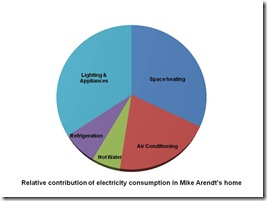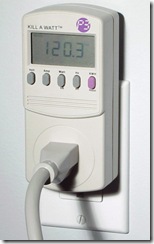 It is widely accepted that “the whole is greater than the sum of its parts”; however, when it comes to energy audits a whole can only equal the sum of its parts. In an audit, the “whole” is the amount of energy consumed, and the “parts” are all of the devices that feed off of your circuit breaker. Therefore, the most critical but also the most tedious element to an energy audit is to get an accurate accounting of those devices (and their usage frequency). As such, patience and a spreadsheet are crucial.
It is widely accepted that “the whole is greater than the sum of its parts”; however, when it comes to energy audits a whole can only equal the sum of its parts. In an audit, the “whole” is the amount of energy consumed, and the “parts” are all of the devices that feed off of your circuit breaker. Therefore, the most critical but also the most tedious element to an energy audit is to get an accurate accounting of those devices (and their usage frequency). As such, patience and a spreadsheet are crucial.
Working from left to right in the spreadsheet, the columns should start with most generic and work their way towards most specific. I like to start with a column for the room and then the appliance type (light fixture, television, etc.). The next column should denote the hourly consumption rate (in kilowatts) followed by an estimate of how many hours per day the appliance is used. Multiply hourly rate by hours used per day and you have the percent daily load.
 Consumption rates for 120V appliances can be monitored with a “kill-a-watt” meter. In some instances the meter is not even needed, for example if you have a light fixture with 4 x 60w bulbs it is understood that the hourly consumption rate for the fixture is 0.240 kw/h. However, for devices with fluctuating energy consumption rates (television, computer, refrigerator, etc.), it is best to log consumption for a suitable period of time using the kill-a-watt meter and then record the average hourly consumption rate later on. If the kw/h consumption rate recorded by the kill-a-watt meter exceeds (voltage x amperage)/1000, the device is exceeding the rated energy draw and may be a fire hazard.
Consumption rates for 120V appliances can be monitored with a “kill-a-watt” meter. In some instances the meter is not even needed, for example if you have a light fixture with 4 x 60w bulbs it is understood that the hourly consumption rate for the fixture is 0.240 kw/h. However, for devices with fluctuating energy consumption rates (television, computer, refrigerator, etc.), it is best to log consumption for a suitable period of time using the kill-a-watt meter and then record the average hourly consumption rate later on. If the kw/h consumption rate recorded by the kill-a-watt meter exceeds (voltage x amperage)/1000, the device is exceeding the rated energy draw and may be a fire hazard.
For hard-wired devices, devices that require 220V (water heater, HVAC, some pool/spa pumps, etc) or 120V appliances with 20A ratings (i.e., the plug prongs are not parallel), the kill-a-watt meter can not be used. For devices that fit this description other than the HVAC or water heater, I recommend estimating hourly consumption rates as kw/h = (volts x amps)/1000. For HVAC, I recommend getting accurate data for everything else and then subtracting the sum of all other uses from the documented annual kwh usage to estimate annual HVAC consumption. However, during the audit you should record the volt and amp ratings associated with the HVAC machinery to refer to later. For water heaters, a mini-audit is required and is addressed in Step 4 under water heater mitigation.
Providing an accurate estimate of device usage is as important as documenting devices and their consumption rates. I like to think in terms of annual usage, which may need to be adjusted for seasonal usage patterns for items like pool pumps. And by accurate, I also mean be honest. People tend to be embarrassed about using too much energy. On the one hand that is good because it means that the user isn’t heartless, but it also can detract from drawing valid conclusions. So remember, if you’re conducting an audit or having one performed, you’ve already taken the critical first step and ‘admitted that there is a problem’, so open yourself up just a little bit more and know that it will ultimately help you and your home heal better.
Click here for Step 4
